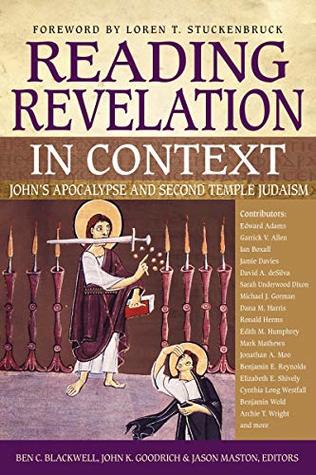More on this book
Kindle Notes & Highlights
John did not invent the image of a divine or messianic warrior; it appears in Israel’s Scriptures and other Jewish writings. One such writing is Psalms of Solomon, which contains what is arguably the most important messianic text in Second Temple literature.
“he shall strike the earth with the word of his mouth forever” (17:35a).
This vision is best understood as an example of ekphrasis, a rhetorical device
that invites the hearer/reader to encounter the person or object described.
Whose Blood? There is a longstanding debate among interpreters of Revelation: In 19:13, is Jesus’s robe dipped in the blood of his enemies or in his own blood? The echo of Isaiah 63:1–6, depicting the divine day of vengeance and the spilling of enemy blood, is clear:
To be sure, Revelation can use blood as a symbol of divine judgment (6:12; 8:7–9; 11:6; 14:20; 16:3–6), but the blood associated specifically with Jesus, as the book progresses and culminates in chapter 19, is his own blood.
Binding Fallen Angels. Verse 4a gives an overview of God’s instruction that Raphael bind Asael and cast him into darkness; then verses 4b–5 explain the details and time frame of that instruction (“make an opening . . . throw him there . . . lay beneath him . . . cover him . . . let him dwell there”). The instruction to “bind Asael hand and foot” conjures the image of a criminal that is arrested, chained, and thrown into a prison (cf. Acts 12:6; 21:11, 33; 22:5). The prison, Doudael, is the equivalent of Sheol, in this case a holding cell until the time of punishment by fire at the final
...more
In this story, the binding and imprisonment of Asael and of Shemihazah marks a watershed moment in the removal of their reign over humanity and the earth. It signals a regime change wherein the evil powers that deceive humanity, victimize God’s people, and ravage the earth are ousted and God is restored as the rightful ruler over humankind, the world, and the cosmos.
short, Satan wages war against the saints by deceiving the whole world in order to establish a pseudo-kingdom.
John has depicted Satan as “the deceiver of the whole world” (12:9 ESV) who wages war against the saints by authorizing the beast/state to establish a pseudo-kingdom and deceive the inhabitants of the earth into false worship on punishment of death.
It is unlikely that either author knew of the other’s book, and it would be misleading to suggest that every point of connection or contrast is significant. But an analysis of how each text has made its own use of common traditions illuminates much that is distinctive about their respective visions.
4 Ezra contains the most daring questions found in any early Jewish or Christian text about God’s justice and mercy in the face of pain and loss.
Zephaniah’s attempted worship is actually rather straightforward: Zephaniah makes a mistake, and the author is able to use this “blunder” to reinforce monotheism.
By making specific reference to the message of the Apocalypse itself, the angel is reiterating that he is not the author or originator of the vision that he has been showing John.
This statement serves not only to subordinate the angel to God but also to elevate the status of his message and to lend legitimacy to John’s book by reinforcing its divine authority.7
In Revelation it comes as a response to the vision itself—“when I had heard and seen [these things],” with “these things” referring to the entire preceding vision.
John’s use of the angelic refusal tradition to reiterate the divine origin of his message is confirmed by a similar scene earlier in Revelation.
“These are the true words of God” (19:9). This declaration prompts John to fall down at his feet in worship. But just as in 22:9, the angel responds, “Don’t do that! I am a fellow servant with you and with your brothers and sisters who hold to the testimony of Jesus. Worship God!” (19:10).
his message to the saints.
So when John uses the angelic refusal scene to elevate the status of his message, he is not elevating his own status as the author, but elevating Christ himself.
apocalypses. Like other apocalypses, Revelation claims that its message is from God himself, and
that he alone deserves to be worshiped. Yet unlike many of these same apocalypses, Revelation makes clear that this worship of the giver of the revelation is to include worship of the crucified, risen, and exalted Christ.
By using the tradition of an angel refusing worship, John is able to reinforce Christ’s role as the giver of the revelation, thus elevating him to the same divine status as God the Father. The angel asserts that John must worship God alone, and the context makes clear that the worship of the exalted Chri...
This highlight has been truncated due to consecutive passage length restrictions.


